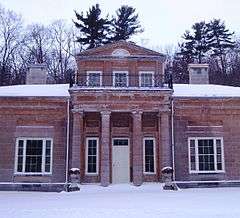Hyde Hall
|
Hyde Hall | |
 | |
| Nearest city | Springfield Center, NY |
|---|---|
| Built | 1817-1834 |
| Architect | Philip Hooker |
| Architectural style | Country Mansion |
| NRHP Reference # | 71000555 |
| Significant dates | |
| Added to NRHP | October 7, 1971[1] |
| Designated NHL | June 24, 1986[2] |
Hyde Hall is a neoclassical country mansion designed by architect Philip Hooker for George Clarke (1768–1835), a wealthy landowner. When built it was the largest private home in the United States. Constructed between 1817 and 1834, it is one of the finest American houses. It combines the architectural traditions of England and America.
It is located in New York within Glimmerglass State Park on Otsego Lake. Also on the grounds, constructed at the same time as the mansion, is Hyde Hall Bridge, a covered bridge.


The building is a New York State Historic Site known as Hyde Hall State Historic Site. It was declared a National Historic Landmark in 1986.[2][3][4]
The George Clarke who commissioned the building was the grandson of another George Clarke (1676-1760), who held several posts in the government of the colony of New York in the first half of the 17th century, including acting governor from 1736 to 1743. The ancestral home of the Clarke family was at Hyde in Cheshire in northwest England, now part of Manchester.[5][6]
The younger George Clarke, having inherited his grandfather's extensive fortune and lands in New York, settled in Albany in 1806. His ownership of much of the land he inherited was long disputed, though he won in the lower courts in December 1815 and his title was vindicated by the U.S. Supreme Court in 1818.[7]
In 1813, Clarke married a member of one of New York's most prominent families, the widow of James Fenimore Cooper's elder brother. In 1817 he purchased lands on Lake Otsego adjacent to his wife's estate and contracted with Hooker for a country villa. The construction project expanded over time, aided in part by Clarke's further inheritance from his father in 1824.
The architecture reflects the building's evolution during the 14 years of its construction, with a series of wings facing a central courtyard. The first phase, the family rooms called the Stone House, is "Palladian in form with a central two story, hip roofed core flanked by one story wings and fronted by a porch". Among its details are "Tuscan piers on the porch, a Palladian window surmounted by an oval arch, five oval windows and simple moldings in a restrained Federal style. The walls are smooth ashlar limestone with a narrow intervening band for every third course. The interior rooms are intimate, focused around a pair of library-living rooms." The second phase, larger than Stone House, contained quarters for servants and services, as well as second-floor bedrooms. Its details are plain in comparison with Stone House and the exterior in fieldstone. The third construction project, the Great House, adopted a neo-Classical style unlike the Palladian. It emphasizes right angles and avoids curved forms for doorways, windows, and moldings. It represents one of the earliest uses of Doric columns found in New York, using a form more slender than their ancient models. As in the second phase of construction, large undecorated ashlar blocks form the walls. The Great House contains two entertaining rooms, a drawing room and a dining room. They are grandly proportioned, each 34 by 26 feet and 19 feet high. The ceilings are elaborately decorated. A smaller pavilion upstairs, reached by a semi-circular staircase, serves as billiard room.
See also
References
- ↑ National Park Service (2007-01-23). "National Register Information System". National Register of Historic Places. National Park Service.
- 1 2 "Hyde Hall". National Historic Landmark summary listing. National Park Service. September 15, 2007.
- ↑ Carolyn Pitts (December 1985). "National Register of Historic Places Inventory-Nomination: Hyde Hall" (pdf). National Park Service.
- ↑ Accompanying photos, exterior and interior, from 1963. (1.85 MB)
- ↑ "Hyde Hall State Historic Site summary". New York State Office of Parks, Recreation and Historic Preservation.
- ↑ "Hyde Hall's Origins". Hyde Hall, Inc. Retrieved August 3, 2015.
- ↑ "Jackson ex dem. People of the State of New York v. Clarke, 16 US 1 (1818)".
External links
- Official website
- NYS Office of Parks, Recreation and Historic Preservation: Hyde Hall State Historic Site
- Historic American Buildings Survey (HABS):
- HABS No. NY-260, "Hyde Hall, East Lake Road Vicinity, East Springfield, Otsego County, NY", 10 photos, 4 data pages, supplemental material
- HABS No. NY-263, "Hyde Hall, Covered Bridge", 2 photos, 2 data pages, supplemental material
- HABS No. NY-264, "Hyde Hall, Gatehouse", 1 photo, 2 data pages, supplemental material
Coordinates: 42°47′32″N 74°52′08″W / 42.792314°N 74.868908°W

